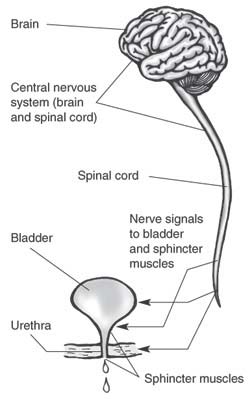Neurogenic Bladder

Neurogenic bladder is the name given to a number of urinary conditions that occur due to damage to the nerves carrying messages between the bladder and the brain.
Bladder muscles may be overactive and squeeze more often than normal and before the bladder is full. Sometimes the muscles are too loose and let urine leak (incontinence). In other people, the bladder muscle may become underactive, meaning it will not squeeze effectively when it is filled with urine and won’t empty fully or at all. The sphincter muscles around the urethra (urine tube) may not work correctly and may stay tight when trying to empty.
The damage may be the result of an illness and injury that affects the brain and/or the spinal cord such as stroke, multiple sclerosis, Parkinson’s disease or diabetes. People who are born with problems of the spinal cord, such as spina bifida, may also have neurogenic bladder.
Testing and Treatment
Neurogenic Bladder Symptoms
The symptoms of neurogenic bladder depend on the type of nerve damage a person has. Symptoms may include:
- Overactive Bladder (often seen in people with strokes, brain diseases and Parkinson’s)
- Urinary Incontinence
- Urinary Retention: This is when you are unable to empty your bladder fully. Some people can only produce a “dribble” of urine. Others strain to push out urine, can’t completely empty their bladder, or can’t urinate at all.
- Repeated Urinary Tract Infections (UTI)
Neurogenic bladder involves the nervous system and the bladder. Doctors will conduct different tests to determine the health of both. Urodynamic testing, a series of tests to measure how well your bladder and urethra function, will provide important information about how to proceed with treatment.
Treatments & Management
Neurogenic bladder is a serious condition, but when it is watched closely and treated the best way, patients can see significant improvements in their quality of life. Treatments include:
- Lifestyle changes such as weight loss, limiting intake of bladder irritating food and drinks and bladder retraining are often the first treatments recommended
- Pelvic floor physical therapy: a health care provider can teach you exercises that you can do to gain control over the bladder muscles.
- Medications are available to help with an overactive or an underactive bladder
- Injections of botulinum toxin (BOTOX®) into the bladder muscle to keep it from contracting too often. This treatment wears off and will need to be repeated in 6-9 months
- Electrical Stimulation and Neuromodulation sends small pulses of electricity to your pelvic muscles to make them tighter and stronger
- Using a Catheter, either intermittently throughout the day or constantly with an indwelling catheter, drains urine from the bladder
- Surgery can help some patients with more serious types of underactive bladder
Frequently Asked Questions
What is a neurologist?
A neurourologist is a urologist whose clinical focus is caring for individuals with urologic problems caused by diseases and injuries to the nervous system.
How does multiple sclerosis affect the bladder?
Up to 80% of people with MS have some kind of bladder problem. The problem varies and can evolve as MS progresses and even include seemingly contradictory components such as overactive bladder and urinary retention. Working with a urologist who specializes in neurourology is very helpful for MS patients.


